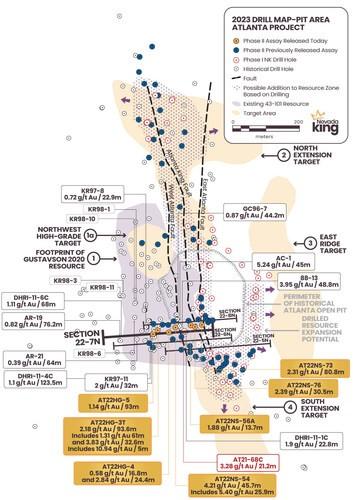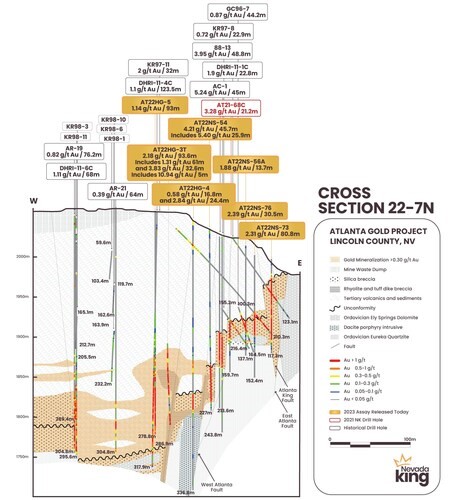
NEVADA KING INTERCEPTS MORE THICK HIGH-GRADE OXIDE GOLD AT ATLANTA WITH 4.21 G/T AU OVER 45.7M AND 2.18 G/T AU OVER 93.6M

Nevada King Gold Corp. (TSX-V: NKG) (OTCQX: NKGFF) is pleased to announce assay results from six reverse circulation holes and one core hole recently completed at its Atlanta Gold Mine Project located 264km northeast of Las Vegas, Nevada, in the prolific Battle Mountain Trend. These holes plotted along Section 22-7N were drilled across the high-grade feeder zone associated with several strands of a braided network of structures comprising the Atlanta Mine Fault Zone.
Highlights:
| Hole No | From (m) | To (m) | Interval (m) | Au (g/t) | Ag (g/t) | Notes | |
| AT22HG-3T*^ | 170.4 | 285.4 | 93.6 | 2.18 | 17.1 | Bottomed in Mineralization | |
| Includes | 170.4 | 231.4 | 61.0 | 1.31 | 0.16 | ||
| And | 252.7 | 285.4 | 32.6 | 3.83 | 48.7 | Bottomed in Mineralization | |
| Includes | 261.0 | 266.0 | 5.0 | 10.94 | 33.2 | ||
| AT22NS-54 | 170.7 | 216.5 | 45.7 | 4.21 | 79.6 | ||
| Includes | 173.8 | 199.7 | 25.9 | 5.40 | 113.8 | ||
| AT22NS-73 | 22.9 | 103.7 | 80.8 | 2.31 | 47.4 | ||
| Table 1: Highlight holes released today. Mineralization occurs along sub-horizontal horizons generally dipping gently westward; true mineralized thickness in vertical holes is between 85% and 95% of reported drill intercept length. *Denotes core hole. ^Reported as an aggregate assay interval within the longer drill interval. | |||||||
- Holes released today tie into two parallel drill sections previously released: Section22-6N (released January 6, 2023) 27.5m to the south and Section 22-8N (released February 1, 2023) 27.5m to the north. Good continuity in geology and Au-Ag mineralization is seen between all three sections, with higher grade mineralization occurring between the East Atlanta and Atlanta King Faults and on both sides of the West Atlanta Fault (Figure 2).
- Section 22-7N demonstrates an east-west width of contiguous mineralization that exceeds 300m. This includes the 100m-wide higher-grade AMFZ, as well as over 200m of lower grade mineralization extending westward from the West Atlanta Fault, where mineralization remains open to depth and to the west.
- Shallow oxide mineralization present in AT22NS-73 (80.8m of 2.31 g/t Au and 47.4 g/t Ag starting at 22.9m) is typical of the thicker, higher-grade mineralization encountered along the 30m-wide, wedge-shaped block occurring between the East Atlanta and Atlanta King Faults. Nevada King is currently drilling along strike of this fault block to better define this near surface, high-grade Au-Ag zone.
- Mineralization in hole AT22NS-54 (45.7m of 4.21 g/t Au and 79.6 g/t Ag starting at 171m) is typical of thicker, higher-grade mineralization seen in down-dropped blocks along the West Atlanta Fault. Immediately west of AT22NS-54 are two historical holes that tested an adjacent fault block, returning 45m at 5.24 g/t Au and 40.7 g/t Ag in AR-21 and 48.8m at 3.95 g/t Au and 46.9 g/t Ag in 88-13 (see Table 3). Taken together, both fault blocks are about 50m wide and strike parallel to the West Atlanta Fault. The Company is currently drill-defining this important structural corridor along strike with the objective of expanding tonnage and grade within a relatively shallow part of the resource zone.
- The broad expanse of deep, lower grade mineralization hosted within variably silicified volcanics and underlying silicified breccia occurring west of the West Atlanta Fault starts at depths of 150m to 250m and typically extends to depths of 300m to 400m, although many of Nevada King’s holes and historical holes bottomed in mineralization, so the lower depth constraint is uncertain. Core hole AT22HG-3T and RC hole AT22HG-4, drilled west of the West Atlanta Fault, intercepted 93.6m averaging 2.18 g/t Au and 17.1 g/t Ag and 41.2m grading 1.92 g/t Au and 22.7 g/t Ag, respectively (see Table 2).
Cal Herron, Exploration Manager of Nevada King. stated, “The four southern-most drill sections (Sections 22-5N, 6N, 7N, and 8N) across the AMFZ show strong correlation of geology and mineralization between the sections, allowing further refinement to our geologic model for the gold and silver mineralization at Atlanta, (see Geologic Model Discussion section below). A primary focus of the 2023 drilling program is defining and following structures responsible for localizing higher-grades. As we’ve already seen, this requires closely spaced holes in order to tie together the fault blocks and wedges hosting high grades along the AMFZ. Nevada King’s new geologic model now gives us a “blue print” for targeting higher-grade Au-Ag mineralization to add to the Atlanta resource model. To this end, one rig is currently engaged in definition drilling along the AMFZ and a second drill will soon be added. At the same time, defining the thick mineralization seen west of the West Atlanta Fault provides significant blue sky potential at Atlanta, where mineralization remains open to depth and to the west. As such, the Company has dedicated one drill for this area in order to vectorize the mineralization and expedite our evaluation process.”
| Hole No | From (m) | To (m) | Interval (m) | Au (g/t) | Ag (g/t) | Notes |
| AT22HG-5 | 186.0 | 279.0 | 93.0 | 1.14 | 2.1 | Bottomed in Mineralization |
| AT22HG-3T* | 170.4 | 231.4 | 61.0 | 1.31 | 0.158 | |
| and | 252.7 | 285.4 | 32.6 | 3.83 | 48.7 | Bottomed in Mineralization |
| Includes | 261.0 | 266.0 | 5.0 | 10.94 | 33.2 | |
| AT22HG-4 | 175.3 | 192.1 | 16.8 | 0.58 | 0.5 | |
| and | 216.5 | 240.9 | 24.4 | 2.84 | 38.0 | |
| AT22NS-54 | 170.7 | 216.5 | 45.7 | 4.21 | 79.6 | |
| Includes | 173.8 | 199.7 | 25.9 | 5.40 | 113.8 | |
| AT22NS-56A | 93.0 | 106.7 | 13.7 | 1.88 | 38.5 | |
| AT22NS-76 | 70.1 | 100.6 | 30.5 | 2.39 | 41.5 | |
| AT22NS-73 | 22.9 | 103.7 | 80.8 | 2.31 | 47.4 | |
| Table 2: All holes released today. *Denotes core hole. | ||||||
| Hole No | From (m) | To (m) | Interval (m) | Au (g/t) | Ag (g/t) | Notes |
| AT21-68C | 99.1 | 120.3 | 21.2 | 3.28 | 34.4 | |
| DHRI-11-1C* | 74.7 | 97.5 | 22.8 | 1.9 | 19.72 | |
| DHRI-11-4C* | 178.3 | 301.8 | 123.5 | 1.1 | 9.0 | |
| DHRI-11-6C* | 227.1 | 295.1 | 68 | 1.11 | 15.72 | Bottomed in Mineralization |
| KR97-8 | 172.2 | 195.1 | 22.9 | 0.72 | 0.72 | |
| KR97-11 | 173.8 | 205.8 | 32 | 2.00 | 9.75 | |
| AC-1 | 118.6 | 163.6 | 45 | 5.24 | 40.7 | |
| AR-19 | 228.6 | 304.8 | 76.2 | 0.82 | 3.52 | Bottomed in Mineralization |
| AR-21 | 240.8 | 304.8 | 64 | 0.39 | 4.21 | Bottomed in Mineralization |
| GC96-7 | 152.4 | 108.2 | 44.2 | 0.87 | 23.18 | |
| 88-13 | 121.9 | 170.7 | 48.8 | 3.95 | 46.9 | |
| Table 3: Previously reported and historic holes used in Section 22-8N. AT21 series hole was drilled by Nevada King in 2021. The KR97 series holes were drilled by Kinross in 1997, the AC series hole was drilled by Goldfields in 1990, and the 88 series holes were drilled by Bobcat in 1988. Due to the multiple orientations of gold mineralization interpreted in today’s release, the Company has not yet estimated true widths for individual intercepts. *Denotes core hole. | ||||||
Geologic Model Discussion
The northerly trending, 100m to 150m wide AMFZ is the dominant structural control over higher-grade mineralization at Atlanta. It focused shallow intrusive activity and the associated hydrothermal system responsible for Au-Ag mineralization. The AMFZ is actually a narrow, up-thrown horst block of Eureka Quartzite and overlying Ely Springs Dolomite that is bounded on the east by the Atlanta King and East Atlanta Faults, and on the west by the West Atlanta Fault and its subsidiary fractures. Gold mineralization preferentially occurs within the Ely Springs Dolomite, whereas the underlying Eureka Quartzite is generally barren. Much of the dolomite in the horst block was stripped off by erosion when the block was uplifted, so the mineralization on top of the quartzite is thin and lower grade. In contrast, thicker and higher grade mineralization was focused in thick sections of down-dropped dolomite within the adjacent graben blocks on both sides of the horst. Normal faults separating these major blocks served as conduits for magma and mineralizing fluids that invaded adjacent dolomite, thereby creating extensive decalcification, collapse brecciation, and subsequent Au-Ag mineralization. Narrow, confined fault wedges adjacent to the major normal faults are altered more strongly and host the highest grades, as seen in drill holes AT22NS-73 and AT22NS-54.
Mineralization west of the West Atlanta Fault occurs within a gently west-dipping sequence of caldera-related volcanics on top of silica breccia and Ely Springs Dolomite. The silica breccia and dolomite are underlain by Eureka Quartzite that is usually barren of mineralization. As seen in Figure 2, faults displacing the basement sequence focus mineralization and strong oxidation. Mineralization within the silica breccia horizon tends to be higher grade and oxidized whereas mineralization in the overlying volcanic sequence is generally low grade (0.2-0.5 g/t Au). Oxidation in the mineralized volcanics appears to be a function of proximity to faults. Historical drill hole density in this area is low, and many of the holes did not penetrate the volcanic cover or go through the silica breccia horizon. We, therefore, have a large, sparsely-tested area to explore all along the western side of the West Atlanta Fault where we are finding a 100m thick, near-horizontal zone of gold mineralization that remains open to the west and to depth.
Qualified Person
The scientific and technical information in this news release has been reviewed and approved by Calvin R. Herron, P.Geo., who is a Qualified Person as defined by National Instrument 43-101.
About Nevada King Gold Corp.
Nevada King is the third largest mineral claim holder in the State of Nevada, behind Nevada Gold Mines (Barrick/Newmont) and Kinross Gold. Starting in 2016 the Company has staked large project areas hosting significant historical exploration work along the Battle Mountain trend located close to current or former producing gold mines. These project areas were initially targeted based on their potential for hosting multi-million-ounce gold deposits and were subsequently staked following a detailed geological evaluation. District-scale projects in Nevada King’s portfolio include (1) the 100% owned Atlanta Mine, located 100km southeast of Ely, (2) the Lewis and Horse Mountain-Mill Creek projects, both located between Nevada Gold Mines’ large Phoenix and Pipeline mines, and (3) the Iron Point project, located 35km east of Winnemucca, Nevada.
The Company is well funded with cash of approximately $9.3 million as of February 2023.
The Atlanta Mine is a historical gold-silver producer with a NI 43-101 compliant pit-constrained resource of 460,000 oz Au in the measured and indicated category (11.0M tonnes at 1.3 g/t) plus an inferred resource of 142,000 oz Au (5.3M tonnes at 0.83 g/t). See the NI 43-101 Technical Report on Resources titled “Atlanta Property, Lincoln County, NV” with an effective date of October 6, 2020, and a report date of December 22, 2020, as prepared by Gustavson Associates and filed under the Company’s profile on SEDAR (www.sedar.com).
NI 43-101 Mineral Resources at the Atlanta Mine
| Resource
Category |
Tonnes
(000’s) |
Au Grade
(ppm) |
Contained Au Oz |
Ag Grade
(ppm) |
Contained Ag Oz |
| Measured | 4,130 | 1.51 | 200,000 | 14.0 | 1,860,000 |
| Indicated | 6,910 | 1.17 | 260,000 | 10.6 | 2,360,000 |
| Measured + Indicated | 11,000 | 1.30 | 460,000 | 11.9 | 4,220,000 |
| Inferred | 5,310 | 0.83 | 142,000 | 7.3 | 1,240,000 |

Figure 1. Location map for holes reported in this news release along drill section22-7N relative to the perimeter of the historical Atlanta Pit and footprint of the Gustavson 2020 NI 43-101 resource. Shallow drillholes on the mine dumps have been removed from the plot for clarity. (CNW Group/Nevada King Gold Corp.)

Figure 2. Cross section 22-7N looking north across the southern portion of the Atlanta Mine Fault Zone. Shallow intrusive activity and closely associated gold mineralization are localized within the volcanic and sedimentary sequence along the western side of the West Altanta Fault. Higher grade mineralization is concentrated within narrow fault blocks formed between the East Atlanta and Atlanta King Faults and along the West Atlanta Fault. (CNW Group/Nevada King Gold Corp.)
MORE or "UNCATEGORIZED"
Kuya Silver Confirms High-Grade Silver-Gold Vein Mineralization at Umm-Hadid with Initial Drill Results up to 1483.9 g/t AgEq over 2 Metres
Kuya Silver Corporation (CSE: KUYA) (OTCQB: KUYAF) (FSE: 6MR1) is... READ MORE
First Phosphate Closes Final Tranche of Oversubscribed Private Placement
First Phosphate Corp. (CSE: PHOS) (OTCQX: FRSPF) (FSE: KD0) is... READ MORE
GFG Receives Final Payment from the Sale of its Rattlesnake Hills Gold Project
GFG Resources Inc. (TSX-V: GFG) (OTCQB: GFGSF) announces that i... READ MORE
Goliath Receives $1,730,882 Through Warrant Exercises, Inclusive Of Crescat Capital A Longtime Strategic And Cornerstone Shareholder
Goliath Resources Limited (TSX-V: GOT) (OTCQB: GOTRF) (FSE: B4IF)... READ MORE
Robex Pours First Gold at Kiniéro on Schedule and Budget
Highlights: Gold bar weighing 2.64 kilograms (85 oz) poured in th... READ MORE












